

Vol. 41 (Issue 10) Year 2020. Page 21
PETROV, Alexander 1; LARIONOV, Arkadij 2
Received: 05/12/2019 • Approved: 13/03/2020 • Published 26/03/2020
ABSTRACT: The solution of economic and social problems in the framework of development of St Petersburg’s engineering infrastructure is a priority task of today’s management practice. The strategic planning makes it possible to regulate relations between the regional market and the rigid system of the centralized state control. The author offers a model of successive interrelated actions taken by all participants of the megaproject. A need is pointed out for using the economic levers and incentives for taking effective decisions. |
RESUMEN: La solución de los problemas económicos y sociales en el marco del desarrollo de la infraestructura de ingeniería de San Petersburgo es una tarea prioritaria de la práctica administrativa actual. La planificación estratégica permite regular las relaciones entre el mercado regional y el rígido sistema de control estatal centralizado. El autor ofrece un modelo de sucesivas acciones interrelacionadas tomadas por todos los participantes del megaproyecto. Se señala la necesidad de utilizar las palancas e incentivos económicos para tomar decisiones efectivas. |
The development of St Petersburg largely depends on how the territories under development are provided with infrastructure services. Due to the complexity, uncertainty and instability of the resource provision and volatility of technological, social and economic environment, the business functions and economic life must increasingly rely on a well thought-out strategy, managerial capabilities and predictable financial factors. However, the experience of strategic management, especially following the 80s, shows that the future becomes harder to foresee, which dramatically hampers the forecast of prospects and likely achievements.
The unbridled market as a tool driving the producers’ capabilities towards meeting the customers’ needs and preferences, was regarded by many investigators as a prerequisite for optimizing the management of centralized economy and as a principal regulator of economic proportions. The possibility of including the market in centralized economy was recognized by such researchers as A. Lerner (The Economics of Control: Principles of welfare economics, 1944), A. Pigou (Employment and Equilibrium, 1949), H. Dickinson (Economics of socialism, 1971), and R. Hall (Introduction to economics, 2000). They believed that the efficiency of using resources in the centralized economy would be much higher if its mechanism were designed based on the principles of free competition with inclusion of market factors for determining the strategic proportions in national economy.
On the other hand, does the consumer society provide sufficient strategic funding for public needs and infrastructure? In Russia, the answer to this question is obvious: the proprietary investors are mainly concerned with business matters and market benefits. Despite the fact that all of the large corporations draw up and analyze different medium- and long-term scenarios, use diverse models for studying the portfolio of capital investments, and resort to skilled experts’ opinions, the corporate insight into the future is still shallow and dependent on profit-making and expansion from without (Ansoff, 1995). According to Galbraith (1988, 1997) conditions are thus created for inequality in profit-making since the planned corporate subsystem employs the market economy structure consisting of small firms and minor companies. The policy of strategic planning and management as pursued by the St Petersburg administration seeks to regulate, by means of intense state funding, the market forces, putting them under orderly control and flexible system of corrective actions. In the era of dynamic strategic management, the difference between ‘private’ and ‘state-supported’ segments of economy can be neglected. In this context the essence of strategic management of engineering infrastructure projects (EIP) in St Petersburg is precisely in the fact that it bridles negative impacts of market forces, simultaneously highlighting the issue of effective implementation of state-funded programs. According to Ansoff (2007), the national economy must increasingly display the political, or the so-called ‘setting’, function of state-supported forecast that forms the structure, proportions, trends and tempos of economic development on a long-term basis. The effective implementation of EIP implies a successive performance of all the stages associated with management (Fig. 1).
Figure 1
Pyramid of strategic management of Saint
Petersburg engineering infrastructure projects
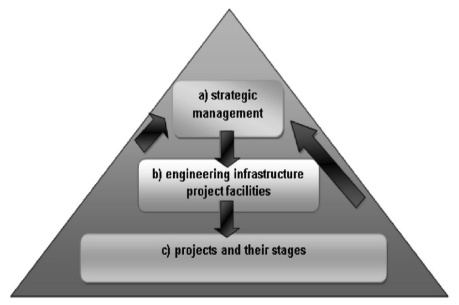
Source: author's elaboration
Larson and Gray (2008) point out the need for strategic project management and define the characteristic features of transition to this essential form of enhancing the economic efficiency of organizations and structural upgrade in conditions of the all-embracing scientific and technological progress. At issue are the stages of designing, including integration of the organization’s project strategy; project goal outline; project plan development; risk management; reduction of project implementation time; scheduled resource management; leadership and project team management; partnership for design; modern trends in project management. The engineering infrastructure projects of St Petersburg included in the city’s strategic development plan (St Petersburg Administration, 2019) display the symptoms of a social project being implemented in community interests. Their special features are:
• a large scale implementation;
• a constituent part of the social development strategy;
• leading role in relation to other elements of the planned events and actions;
• comprehensive and all-inclusive nature;
• relevance to all functions of the urban territory;
• comprehensive financial and managerial support.
The EIP strategic management purposes are: reduction of the cost of project implementation and operation, capability to adapt to changes in the development of St Petersburg; functionality, comprehensiveness and capability for integration. For achieving the outlined goals it is essential to:
• choose the implementation method (a locally major project, successive project implementation, simultaneous implementation of several projects);
• choose the form of the strategic engineering infrastructure management (package of actions interrelated in terms of resource supply, timeframe, and contracting parties);
• create a strategic management mechanism for specific conditions.
The decisive factor in the EIP strategic management is technological progress, universal but often destructive by nature, whose innovations replace the previous economic pattern (Schumpeter, 2013). Innovation resulted in organizational and plan-related efforts which as such are based on certain theoretical principles. The use of theoretical methods in fundamental investigations smoothly blends with introduction of methods that can be directly employed to produce goods and provide services. The scientific and technological studies are carried out on a planned basis in that they are performed using a tested methodology and comply with preset goals. Such technological evolution directly influences the goods supply policy and drives companies and corporations through the ‘filter’ of strategic management (Lambin et al., 2007). The problem is that the economic pattern is often regarded as a package of unchangeable existing structures. To this day, the researchers are still preoccupied with competition proceeding in the framework of unchangeable conditions, in particular, unchangeable means of production and forms of organization. However, in actual fact a different type of competition takes place, which is based on discovery of new technologies, new sources of raw materials, and new kinds of organizations (for example, major corporations). This competition dramatically cuts the cost and improves the quality, which is spells utter bankruptcy to the existing companies. This is precisely what is known as ‘creative destruction’ of structures and institutes of capitalism, i.e. undermining of competition and weakening of the human factor in entrepreneurship (Schumpeter, 2013, p. 81).
The following should be noted here. The American economist Ciscel (1984) defined the concept of the planning system as a substitute of the market theory. As a result of the ‘creative destruction’ in the mature corporations and in the planning system of the 21st century the power and management have shifted from proprietors to techno structure consisting of engineers and technicians who are not proprietors. The techno structure, according to Ciscel (1984, p. 412), is a ‘social class whose position in economics is determined by its participating in strategic decision-taking process; this class is controls the property without owing it’. In this connection it is safe to say that the fate of any strategic decision is in the hands of techno structure. In the age of uncertainty the large corporations’ techno structure is greatly tempted to subjugate the techno structure represented by state functionaries and to use the advantages of strategic planning for achieving their selfish lucrative purposes. It should be borne in mind that on all the markets a developed corporation seeks to secure itself against risks and uncertainties, thus striving for a solid profit, and exclusive and reliable position in the political and economic environment (Stockhammer, 2006).
Thus it needs to be pointed out that any firm or corporation is involved in power struggle and operates as an element of power relationship since as an organization it functions in conditions of competitive environment (Bernhagen, 2007). In other words, it participates in struggle for power in order to attain its goals. In many aspects the dynamics and efficiency of the organization’s progress are determined by the levels of inter-organizational interactions and intra-organizational processes. The lust for power (to move from one level to another) drives the participants of the market competition to introduce innovations, offer new products and services, and actively promote their goods on the market. As Schumpeter (2013) notes, the conduct of the innovator entrepreneur is motivated firstly not by monetary profits but by the desire to obtain power and prestige and thus to create a ‘private kingdom’ of his own.
The studies on the St Petersburg EIP were carried out by methods that can be divided in two groups: contents-based and formalized. For building a contents-based aspect of the article the author used the following methods: Ansoff’s ‘strategic management’, Schumpeter’s ‘creative destruction’, and Galbraith’s ‘new industrial society’. The logical and comparative study with highlighting of structural characteristics of the object under consideration is actually a formalized investigating method. In order to control the strategy implementation process and be sure about the achievement of the assigned goals, the organization’s executives must develop plans, programs, projects and budgets, to motivate the process and keep it under control. The strategic decision-making is a choice of what and how must be planned, organized, motivated and controlled. In the most general of terms this makes up the essence of the executive’s work. However, given that there is no single strategy for all, each company seeking its niche in the stiffly competitive market, develops its own strategy based on analysis of environment and own capital, and striving to achieve the organization’s goals and perform its mission. In this plan, in order to clarify the dynamics component the EIP employed the method of the capabilities matrix applied to the markets, goods and services (Fig. 2).
Figure 2
Capabilities matrix by
products and markets
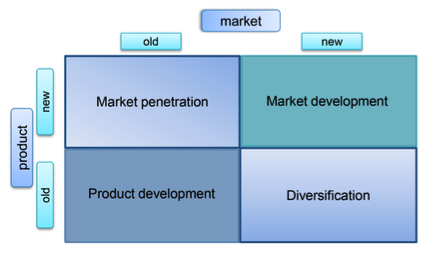
Source: author's elaboration
According to the matrix, there are 4 types of strategy: market penetration; market development, product development, and diversification. The choice of strategy and, hence, the management effectiveness depends on the degree of market saturation and the company’s capability to steadily upgrade the production. For analyzing the strategic EIP investment, a matrix of the Boston Consulting Group (BCG) is given (Fig. 3).
Figure 3
BCG model for analyzing
the strategic management
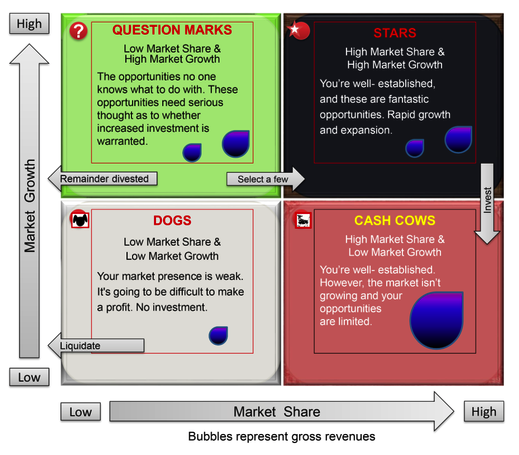
Source: author's elaboration
A few words must be supplied on the subject of BCG matrix itself. The business areas conditionally referred to as ‘stars’ can be called the leaders in their fields. They bring very high profits. However, the main problem is the return on investments. Cash cows are ‘the starts of the past’ which currently ensure a fairly high rate of profit. The cash flow in these positions is well balanced because investments in such business need a mere minimum. On the contrary, the so-called ‘dogs’ are businesses with a relatively small share on the market in slow developing branches. The cash flow in these business areas is usually negative. Question marks are a zone of risks, but with potential benefits estimated as high (Table 1) (Madsen, 2017).
Table 1
Characteristic of business
zones according to matrix BCG
Conventional definition |
Market share |
Market growth |
Required investment |
Profit |
Company goals |
Stars |
Big |
High |
Big |
High |
Optimizing size of investments to ensure payback thereof in future |
Cash cows |
Big |
Low |
Small |
High |
Supporting status quo. Monitoring market evolution with the aim of determining the stage of closure. |
Question marks |
Small |
High |
Big |
Small, absent or losses |
Increasing investments with the aim of increasing competitiveness, protection and subsequent market share increase |
Dogs |
Small |
Low |
Small |
Very small absent or losses |
Analyzing possibility' of market share increase (e.g. by means of niche occupation). Exit of the market, if it is impossible |
Source: it’s created according to Madsen D.Ø. (2017). Not dead yet: the rise, fall and
persistence of theBCG Matrix. Problems and Perspectives in Management, 15(1), 19–34.
Due to the increased dynamics of our era and the increasing uncertainty of the future, the major project implementation issues, including those of engineering infrastructure development, have drawn acute attention from the world over. So, in implementation of a large infrastructure project of the Olympic stadium in the UK, a number of innovative developments (Jackson & Bonard, 2011, Crockford et al., 2011) were involved. In Sidney, Australia, innovations made it possible to complete construction of a large stadium with a possibility of comprehensive servicing of different sporting events (Morley et al., 2000). During construction of the stadium in Athens a rather unusual high-technology building method was used which enabled completion of work within the scheduled timeframe (Siriani & Silverio, 2006). In Dublin, a major project was implemented for development of infrastructure, particularly in the field of transportation, power supply, and water supply systems etc. (Hunt et al., 2012). In Dubai, the United Arab Emirates, an evaluation was carried out on an advanced alternative power supply project: solar energy, geothermal energy, wind produced energy, etc. (Hadjri & Onyango, 2013). Bell (2013) noted the importance of controlling the urban infrastructure in today’s urbanization and climate change. St Petersburg is located on 47 islands of the Neva Delta. The St Petersburg Engineering Infrastructure can be regarded as a single multi-project which includes a multitude of interconnected projects (Petrov, 2014) (Fig. 4).
Figure 4
Saint Petersburg Master Plan till 2035
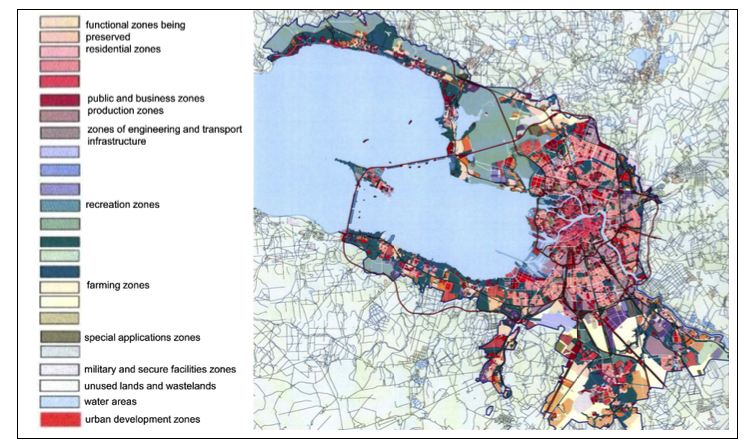
Source: http://forum.spb-projects.ru/gp/spb_gp.jpg
The integrity of this infrastructure is based on a balanced system of economic power which contributes to:
• efficiency and order in the economic area;
• reduction of transactional costs;
• certain unpredictability in the conduct of economic agents for reducing the losses caused by casual and unpredictable actions.
More than 67 projects are under development in the city, including 44 projects of comprehensive development of the former industrial zones and 23 building development projects. In case of their implementation, 36.3 million square meters of housing area will be introduced. The largest complexes among them are ‘Severnaya Dolina’ (Northern Valley), ‘Yuntolovo’, ‘Novaya Izhora’ (New Izhora), ‘Slavyanka’, ‘Baltiiskaya Zhemchuzhina’ (The Baltic Pearl) as well as residential compounds like ‘Sophia’, ‘Triumph-Park’, ‘Orbita’, ‘Lastochkino Gnezdo’ (Swallower’s Nest) and others. It is planned, under the 83 facility erection plan, to build more than 26 million square meters of housing area. Among them are such satellite towns as Yuzhny, Bolshoi Pushkin, Novy Pushkin, Murinsky Kvartal, Novo-Sergiyevo, Ruchyi, Tsvetnoi Gorod, and Planetograd. A number of disproportions and misbalances hamper the implementation of the dynamic model of strategic development in St Petersburg. Those drawbacks include:
• glaring domination of short-term corporate and commercial interests over long-term public interests of territory development;
• low social efficiency of using the land, the city’s chief strategic resource;
• the pronounced shortages in engineering, transport and social infrastructure of the newly built-up territories;
• lack of architectural identity in St Petersburg contributing to the extensive growth of the city via uncontrollable territory development;
• concentration of business activity in central districts that triggered pendulum-like migration of the population in peripheral districts;
• lack of fully fledged land market and, hence, the shortage of prepared and formally legalized land plots for investments;
• poorly controllable amendments to the Master Plan in relation to private projects and problems;
• redundant regulation that has become completely bureaucratic with missing clear-cut strategy of extensive development;
• the errors, over the last several years, in strategic management that lead to wrong forecasts for state-supported enterprises maintaining alternative-free economic efforts, which results in their closure and bankruptcy.
Even though the progress of technology has dramatically changed the strategic planning, bringing it closer to the quality characteristics of the living standard, the economy of St Petersburg is overall characterized by a high level of wear of the manufacturing facilities and low competitiveness of the products it turns out. According to Petrostat, the Statistics Committee of St Petersburg, the value of per capita GRP (gross regional product) in 2012 amounted to US$ 11.3 thousand. The economic development of St Petersburg is largely based on the use of infrastructure facilities and the achievements in science and technology attained during the Soviet era. The majority of major and medium enterprises making up the backbone of the city’s economy had been built or modernized as far back as the years of Soviet power. By modern standards, they are non-optimally located and feature a low mobility of manufacturing assets. Such enterprises are unable to promptly respond to changes in the market situation and have difficulties in introducing new technologies. The problem of technological modernization is aggravated by a heavy dependence on imports, including modern equipment, and many types of components and spares. Thus we can state the following: from 2010 through 2013, the economy of St Petersburg did not function very well. The causes of this are the low efficiency of using the assets and inferior productivity at a high energy consumption.
Over the years, transport has been St Petersburg’s most capital intensive branch of economy. This accounts for 20% of all investments, made in the city’s economy. In 2011, most of foreign capital was invested in manufacturing industry (71.5%), whereas the bulk of foreign investments went to commercial and other credits. In 2013 according the Petrostat the economy of St. Petersburg has received $ 1383.9 million direct investment, but in 2015 according the Central Bank of the Russian Federation the economy of St. Petersburg has received $ 5.3 billion direct investment. On the one hand, it should be borne in mind that the capital intensive sectors of economy are not profitable and do not bolster entrepreneurship and the desire to improve the management principles, while technological breaks-through, resource shortage, and changes in the market structure generally complicate its transformation. The forms of economic management based on large-scale state-supported industrial complexes (Gazpromneft, Transaero, SIBUR, Sovkomflot and others) cast doubt on the economic effectiveness of strategic planning. In addition, the gigantic monopolistic corporations are a refuge both for sectoral and national techno-structure making super-profits by exploiting small firms.
The project effectiveness is one of the essential criteria for decision-making and project implementation. Today, in St Petersburg the choice of the best projects, in terms of project effectiveness, is made based on the UNIDO (United Nations Industrial Development) method. The goals of EIP strategic management are: reduction of project implementation and operation costs, ability to adapt to changes taking place in St Petersburg, functionality, comprehensiveness, and ability to integrate. For achieving the established goals it is essential:
• to choose an implementation method (locally large project, successive project implementation, simultaneous project implementation);
• to choose a form of strategic management applied to the engineering infrastructure (packages of actions interconnected in terms of resources, timeframe and contractors);
• to create a strategic management mechanism applied to specific conditions.
• In order to make the St Petersburg development multi-project effective it is necessary to elaborate a relevant mechanism (Fig. 5).
Figure 5
Pyramid of implementing the
development multi-project
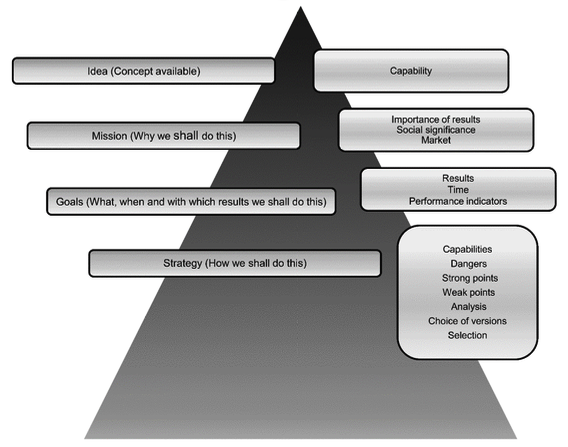
Source: own elaboration
The task of creating the mechanism of EIP implementation and effectiveness of strategic decisions: During implementation, each project undergoes the following stages: conception, planning; realization; completion. In conditions of a post-industrial society with its high tempo of changes, unpredictability, and instability, the creation of a new EIP mechanism is a very hard job. It cannot be done based on the previous experience and is characterized by the complexity of managerial problems and the obvious shortage of managerial skills as such. Given that the project is a purposeful change of an individual system restricted by a timeframe with initially well defined goals, whose attainment means completion of the project, and whose temporal requirements, results, risks, funds, resources and structural specifics are clearly established, it is necessary to indicate its service life (Petrov, 2004). In case of an optimal estimation of the strategic capital investments and mobilization capabilities the EIP management comes functionally close to the systematic and program engineering. The experience shows that the rightly chosen architecture of the information system is an important basis of strategic substantiation of EIP (Bond & MacLeod, 2001; Motamedi & Milani, 2011). Having developed an integrated system of project management at the regional level, it is necessary to establish if it includes the following functions:
• determination of EIP composition and stages;
• determination of functions of EIP management system;
• substantiation and decomposition of EIP management facilities;
• determination and information interconnected support of applied tasks of EIP management system;
• consideration of different forms and sources of funding (in case of budgetary funding, federal agency-private enterprise partnership, corporate fixation, etc.).
In performance of such tasks the simple extrapolation of previous trends yields no results. In addition, the probability of unpredicted occurrences in strategic management is extremely high, which implies the steady growth of unstable conditions. So, how to choose the right strategy under such circumstances? Hence we can draw a very simple conclusion – optimum will be such a competitive strategy which improves the forecasting capability. The more alternatives we obtain in managerial practice, the steadier our position becomes. Such is the dialectics of strategic forecast. One must give up the idea that the future is bound to be inevitably better than the past. The aim of this approach is to show the dangers, trends and disasters that may occur under the newly arisen circumstances.
As a rule, modern strategic management encounters problems that arise unexpectedly and contrary to all envisions, triggering new problems whose settlement calls for original solutions. Let us see what is included in the EIP strategic management in St Petersburg. Here we shall discover three elements: EIP management system, corporate EIP management system; and EIP strategic management system.
1) The EIP management system architecture includes the following aspects:
• Technical and technological: document development; work planning; engineering; logistic and technological support; software and information support; organization of technological processes; execution of work; budgets; accounting.
• Social and labor-related functions: interrelations within the project team; relationships between the team and project participants; relations with external environment; conflict settlement; negotiations and conferences; incentives package; social measures package.
2) The architecture of corporate EIP management system is oriented to a package of projects and includes; project selection; monitoring; resource redistribution among projects; evaluation and efficiency improvement.
3) Architecture of the strategic EIP management system includes: strategic planning; organization; norms and standards development; computerization; controlling.
During functioning, each of the said systems has its special features and capabilities (Table 4).
Table 2
Characteristic of types of
systems of projects control
System tyре |
Characteristic |
Project control system (PCS) |
Oriented to particular project |
Corporate projects control system (CPCS) |
Oriented to complex of engineering infrastructure projects |
System of strategic projects control |
Incorporates mechanisms of PCS and CPCS and is oriented to megaproject |
Source:own elaboration
From here it is obvious that in order to cope with the rapidly changing missions and to timely choose the right solution, a control method is used known as the ranging of strategic systems and relevant tasks (Larionov, 2018; Larionov & Nezhnikova, 2016a; 2016b). Its essence is in the fact that once the situation starts to change quickly and the developments become extremely unstable, it is essential to make a timely decision how to tackle the issue and to prepare (sometimes urgently) the relevant tactics, including the readiness to take risky measures. The important mission of the EIP strategic management system is integration of all mechanisms in a single complex and reception of maximally complete information for easing coordination and improving the harmony, reliability and effectiveness of their operation (Fig. 6).
Figure 6
Strategic management of engineering
infrastructure development projects
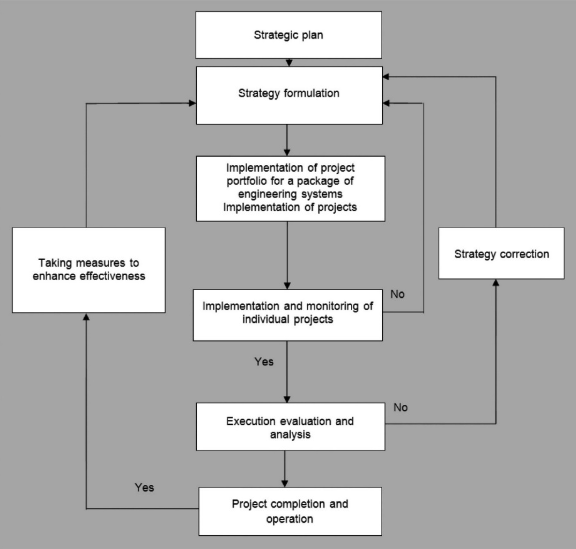
Source:own elaboration
Such a method of decision-making ensures a sufficiently high financial efficiency. In order to successfully cope with the rapidly changing circumstances the following is necessary:
• the contents of the strategic plan includes: outlining the target of engineering infrastructure development, estimation of resources, estimation of external environment, formulation of the project budget, administrative interaction;
• strategy formulation is associated with: diversification of engineering infrastructure, grouping of facilities in an integrated projects system with regard to each type of engineering systems, formation of corporate systems of project management;
• realization of project portfolio for a package of engineering systems implies the following jobs: availability of a corporate executor, development of regulatory, legal and methodological basis, development of timeframes and procedures, creation of an information system for managing the projects portfolio, personnel motivation;
• implementation of individual projects implies realization of processes and monitoring. It is necessary to have a capability of monitoring all the key components and stages of project implementation. Referred to them are: project targets, timeframe, budget, resources, and results at the stages of conception, planning, execution, termination and operation of the project. The mechanisms of monitoring the condition of individual components and stages of the project make it possible to receive operative information about the process of its implementation;
• evaluation of execution and analysis allow predicting future problems. Operative reception of information on project implementation permits tracking of the changes in the project plan. It is necessary to analyze the availability of documents concerning the project execution in terms of enhancing the rate of profit and effective use of technological developments. The minimum requirement is evaluation of documents in terms of components and stages of project implementation. For this purpose it is essential to take timely decisions on suspension or resumption of project implementation. Due attention must be given to mechanisms of operative reception of information for amending the strategy.
• project termination and operation implies: general conclusion and analysis of preparation of the report on execution, and the formation of flexible systems of gathering information on the course of project operation.
For building an effective system of engineering infrastructure development in St Petersburg it is necessary to harmonize and interconnect the federal programs, state-funded projects, comprehensive infrastructure development plans due to be realized in the city and in the framework of EIP and corporate schemes. Such interconnection must take into account the principal aims and tasks and cover all the participants involved in the development of engineering infrastructure (Fig. 7).
Figure 7
Interconnection of programs, projects and participants
in implementing engineering infrastructure projects
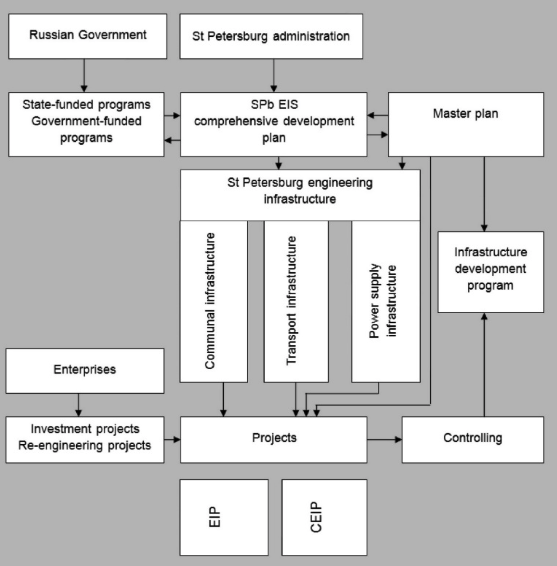
Source:own elaboration
Package of tools for priority project development and implementation: It is possible to define the functions and adequately distribute resources, including finance, among all the participants, programs and projects on the basis of a model that establishes the sequence and interconnections between all those involved in the megaproject. This is required for forecasting the duration of the service life of all contributors to the city’s political and economic environment. The thing is that as a result of advanced innovations in the management and in improvement of efficiency of the companies’ operations, accelerated development of new products and other progressive trends, the duration of service life of economic entities becomes directly dependent on the preparedness to develop new types of activities which are in line with the financial growth and profitability (Repenning & Sterman, 2003, Smirnova, 2018). The model embraces all the programs, projects and project packages as well as stages of their life cycle (Fig. 8) (Larson & Gray, 2008).
Figure 8
Project life cycles
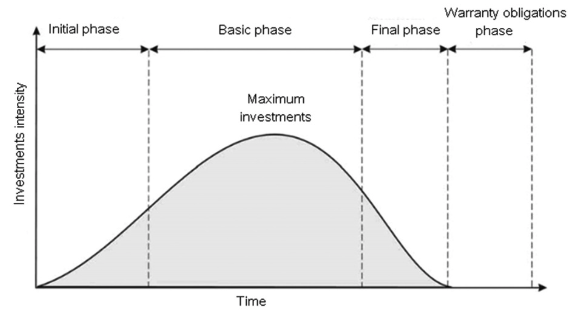
Involved in the process are not only the company’s insider specialists, but also outsider experts. The project life cycle must coincide with the existing business processes in the companies and the functionality of the structural subdivisions of St Petersburg administration and end with a recoupment period (Fig. 9) (Larson & Gray, 2008).
Figure 9
Life cycle of a project whose completion
date coincides with its recoupment time
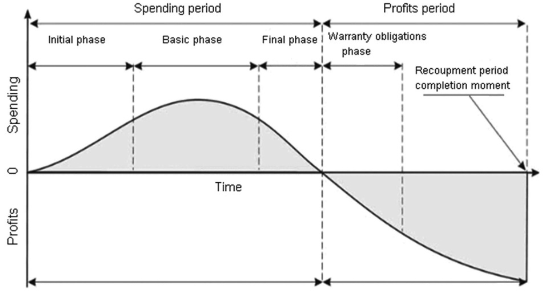
Source: It’s created according to Larson E.W. & C.F. Gray (2008).
Project Management: The Managerial Process (McGraw-Hill/Irwin Series
Operations and Decision Sciences). 4th ed. McGraw-Hill/Irwin, Boston, US.
Otherwise the area of possible losses will exceed the amount of expected income and thus we shall risk not only losing the income but shall be liable to sustaining direct losses equal to all the expenses incurred. Key events are pointed out inside each stage (designing, funding, etc.) which are equivalent to taking an important decision on further project development and improvement. The progress is steady and gradual. The main tasks of such division in stages are a step-by-step elimination of uncertainty and instability (technological in the first place) as well as reduction of investment risks both for the companies and the administrations of St Petersburg and the Russian Federation. In order to take an adequate decision on resource distribution which ensures competitiveness and bolsters the development strategy, it is necessary to eventually select a fairly narrow range of investment zones. Otherwise such decisions will become virtually invalid (Sterman, 2000). Thus an addressing system will be formed for engineering infrastructure facilities, and management strategies will be elaborated reliant on the methodical thinking and efficient human factor. Here it is worthwhile remembering Russia’s until now effective BCG-matrix though for counting the maximum growth of investment it should be borne in mind that there is a certain amount of optimum capital investments whose excess (especially in the long term perspective) starts to reduce the growth.
The efficiency of the strategic management system in St Petersburg’s EIP also depends on the choice of the optimum organizational structure (Table 3) (Ansoff, 1995; Jones, 2013; Serifi & Dašić, 2012).
Table 3
Selecting optimal
organizational structure
Structure |
Uncertainty |
Technology |
Duration |
Number of participants |
Importance |
Interrelations |
Deadline |
Traditional structure |
for routine projects |
standard technology is used |
for short projects |
low |
for projects of low importance |
project covers only one functional division |
project implementation deadlines are not critical |
Projectized structure |
|
for new technology |
for durable projects |
high |
for very important projects |
for projects wit strong interrelations |
limiting deadlines |
Matrix organizational form |
for projects of medium uncertainty |
standard technology is used |
for projects of medium duration |
low |
for projects of medium importance |
covers several divisions |
medium criticality of deadlines |
Strong matrix |
for projects of strong uncertainty |
for complex technology |
|
medium |
|
|
|
Source: It’s created according to Ansoff, H.I. (1995). Corporate Strategy: An Analytical
Approach to Business Policy for Growth and Expansion. McGraw-Hill, New York, US.
Jones, G.R. (2013). Organizational Theory, Design, and Change. 7th ed. Prentice Hall, New Jersy.
Serifi, V. & P. Dašić (2012). Characteristics of traditional and contemporary models of organizational structures. 7th International Conference ‘Quality, Management, Environment, Education, Engineering’ (ICQME-2012), 19.09.-21.09.2012, Tivat, Montenegro ( pp. 333-339). Faculty of Mechanical Engineering, Podgorica, Montenegro.
Thus the EIP strategic management model under consideration:
is a sophisticated hierarchical system of successive and interconnected actions of all megaproject participants;
in implementation of EIP this model of successive and interconnected actions of all participants will enable adjusting other programs and projects of the megaproject;
realization of this mechanism will improve efficiency of the strategic plan aimed at developing St Petersburg’s social and economic sectors;
At the same time, the disproportions and negative processes in the city’s progress hamper transition to a dynamic model of the strategic plan. In other words, the mechanisms of successful strategic management based on the human factor, remain thus far disabled. Among the chief causes of the managerial recession is the solid power of techno structure taking strategic decisions in the interests of the ruling oligarchic group. Another cause is the shortage of managerial solutions and initiatives provoked by deterioration of the human factor as such in Russia,
In the modern world the regions develop based on the principles of stability, which implies complete satisfaction of current needs without harming the future generations. On the contrary, the city’s development strategy till the year 2035, addresses only current tasks in the work of major corporations. It is very inefficient for social purposes and improves the quality of current life very little, if at all. What happens is the abandoning of a comprehensive solution to the problems of the megacity in favor of corporate solutions that slow down the process of inevitable erosion of the infrastructure. Under the existing circumstances this does not settle the crisis, leading instead to unjustified loss of resources, something Russia is known to be never short of.
Ansoff, H.I. (1995). Corporate Strategy: An Analytical Approach to Business Policy for Growth and Expansion. McGraw-Hill, New York, US.
Ansoff, H.I. (2007). Strategic Management. Palgrave Macmillan, Houndmills, UK.
Bell, S. (2013). Briefing: Creating sustainable urban water systems. Proceedings of the ICE – Urban Design and Planning, 166(2), 95–102.
Bernhagen, P. (2007). The Political Power of Business: Structure and Information in Public Policymaking (Series: Routledge Research in Comparative Politics, vol. 21). Routledge, London, UK; New York, US.
Bond, A.J. & I.A. MacLeod (2001). A strategy for computer modeling in geotechnical design. Proceedings of the ICE – Geotechnical Engineering, 149(2), 95–102.
Ciscel, D.H. (1984). Galbraith's planning system as a substitute for market. Journal of Economic Issues, 18(2), 411–418.
Crockford, I., Breton, M., McCormick, F., Johnson, P. (2011). Delivering London 2012: The Olympic Stadium. Proceedings of the ICE – Civil Engineering, 164(6), 37–43.
Galbraith, J. (1988). Economics and The Public Purpose. New American Library, New York, US.
Galbraith, J. (1997). The Age of Uncertainty. Houghton Mifflin, Boston, MA, US.
Hadjri, K. & J. Onyango (2013). The Sustainability of new urban developments in Dubai. Proceedings of the ICE – Urban Design and Planning, 166(2), 119–125.
Hunt, D., Lombardi, D., Jefferson, I., Rogers, Ch., Butler, D., Memon, F. (2012). Appraising infrastructure for new towns in Ireland. Proceedings of the ICE – Urban Design and Planning, 165(2), 103–121.
Jackson, R. & C. Bonard (2011). Delivering London 2012: Environmental management. Proceedings of the ICE – Civil Engineering, 164(5), 20–26.
Lambin, J-J., Chumpitaz, R., Schuiling, I. (2007). Market-Driven Management: Strategic and Operational Marketing. Palgrave MacMillan, Basingstoke; New York, US.
Larionov, A. (2018). Organizacionno-jekonomicheskie I tehnicheskie problemy obespechenija jenergojeffektivnosti pri stroitel'stve i jekspluatacii mnogokvartirnyh zhilyh domov [Organizational, economic and technical problems of energy efficiency in the construction and operation of multi-apartment buildings]. Jekonomika Stroitel'stva [Economics of Construction], 1(49), 18–26.
Larionov, A. & E. Nezhnikova (2016a). Energy efficiency and the quality of housing projects. ARPN Journal of Engineering and Applied Sciences, 11(3), 2023–2029.
Larionov, A. & E. Nezhnikova (2016b). Role of energy efficiency in improving the quality of housing projects. International Journal of Applied Engineering Research, 11(6), 4433–4439.
Larson E.W. & C.F. Gray (2008). Project Management: The Managerial Process (McGraw-Hill/Irwin Series Operations and Decision Sciences). 4th ed. McGraw-Hill/Irwin, Boston, US.
Madsen D.Ø. (2017). Not dead yet: the rise, fall and persistence of theBCG Matrix. Problems and Perspectives in Management, 15(1), 19–34.
Morley, S., King, A., Ashfield, M. (2000). Stadium Australia: For 2000 Olympics. Proceedings of the ICE – Structures and Buildings, 140(4), 307–314.
Motamedi, D. & A.S. Milani (2011). Improving damage resistance of a composite pole using a computer experiment strategy. Proceedings of the ICE – Engineering and Computational Mechanics, 164(3), 171–181.
Petrov, A. (2004). Metodologija povyshenija organizacionno-jekonomicheskoj ustojchivosti voenno-stroitel'nyh predprijatij [The Methods of Enhancing the Organizational and Economic Stability of Military Construction Enterprises]. Dis. Thes. for the D.Phil. in Economics (D.Eco.). St Petersburg State University of Architecture and Civil Engineering, St Petersburg, RU.
Petrov, A. (2014). Strategic planning in Saint Petersburg as a manifestation of transition to sustainable development economy. Middle-East Journal of Scientific Research, 21(2), 423–426.
Repenning, N.P. & J.D. Sterman (2003). Nobody ever gets credit for fixing problems that never happened: creating and sustaining process improvement. California Management Review, 43(4), 64–88.
Schumpeter, J.A. (2013). Capitalism, Socialism, and Democracy. Routledge, London, UK.
Serifi, V. & P. Dašić (2012). Characteristics of traditional and contemporary models of organizational structures. 7th International Conference ‘Quality, Management, Environment, Education, Engineering’ (ICQME-2012), 19.09.-21.09.2012,Tivat, Montenegro ( pp. 333-339). Faculty of Mechanical Engineering, Podgorica, Montenegro.
Jones, G.R. (2013). Organizational Theory, Design, and Change. 7th ed. Prentice Hall, New Jersy.
Siriani, F. & D. Silverio (2006). How Athens’ Olympic stadium was finally pulled together. Proceedings of the ICE – Civil Engineering, 159(3), 114–119.
Smirnova, E. (2018). Control capability of environmental safety in the context of 'green' construction paradigm. Espacios, 39(22), 40.
St Petersburg Administration (2016). Strategy of economic and social development of St. Petersburg until 2035. https://www.gov.spb.ru/gov/otrasl/c_econom/strategiya-ser-2035/
Sterman, J.D. (2000). Business Dynamics: Systems Thinking and Modeling for a Complex World. Irwin McGraw-Hill, Boston, US.
Stockhammer, E. (2006). Uncertainty, class and power. Journal of Political Economy, 35, 31–49.
1. DSc in Economics, Professor. Saint Petersburg State University of Architecture and Civil Engineering. Vtoraja Krasnoarmejskaja ul. 4, St. Petersburg, 190005, Russia. E-mail: prof_petrovaa@mail.ru
2. DSc in Economics, Professor. Moscow State University of Architecture and Civil Engineering. Yaroslavskoye Shosse, 26, Moscow, 129337, Russia. E-mail: proflarionov@mail.ru
[Index]
revistaespacios.com

This work is under a Creative Commons Attribution-
NonCommercial 4.0 International License